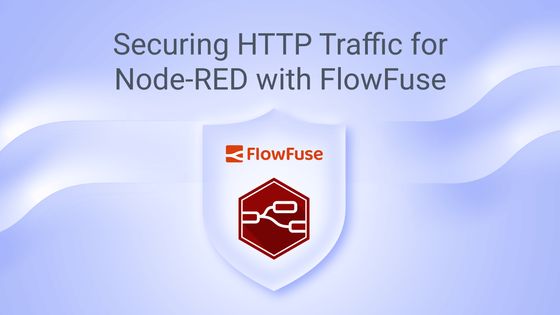Securing HTTP Traffic for Node-RED with FlowFuse
Choosing the right form of authentication for your Node-RED integration is important.

Citizen development empowers employees to create digital solutions. However, it requires guardrails to ensure data security, operational stability, and compliance. These guardrails are what FlowFuse provides to the Node-RED community to level up their deployments. FlowFuse offers many different security measures for authentication and authorization, which all apply to different scenarios.
In this post we’ll take a look at most of them, specifically for HTTP traffic. We’ll discuss the trade-offs for auditabliltiy, convenience to use as either machine or human, among other factors.
HTTP Basic Authentication: A Simple Approach
HTTP Basic Authentication is widely supported and straightforward to implement, making it a popular choice for securing APIs. It requires users to provide a username and password before accessing the Node-RED instance. While this method is easy to use, it's important to note that the username and password are shared and transmitted in plain text, making it vulnerable to interception if the connection doesn't leverage SSL/TLS. FlowFuse by default ensures SSL/TLS is deployed.
Personal access tokens: Knowing who accessed the Node-RED
Personal access tokens (PATs) are an essential component of FlowFuse, allowing users to securely access their accounts without sharing their passwords. These tokens are generated by the user and can be used to authenticate to the SaaS product's API or other services. PATs provide a more secure alternative to traditional username/password authentication, as they can be revoked or regenerated at any time, limiting the potential impact of a compromised token.
FlowFuse Authentication: Seamless Integration
FlowFuse authentication offers a seamless and secure way for users to access dashboards and other resources that are typically accessed through a browser. It leverages single sign-on (SSO) and SAML 2.0, reducing the management burden for organizations.
For users this is convenient as they can access multiple applications and resources using a single set of credentials, eliminating the need to remember and manage multiple passwords.
For organizations, SSO enhances security by centralizing authentication and authorization, reducing the risk of unauthorized access. By leveraging SSO and SAML 2.0, FlowFuse takes care of user management, freeing up customers from the administrative burden of managing user accounts and passwords. FlowFuse authentication adheres to industry-standard security protocols, ensuring compliance with regulatory requirements.
This method of authentication is however impractical for API access by other services, to programmatically transfer data between them.
Bearer Authentication: A Token-Based Approach
Bearer Authentication offers a more secure and flexible alternative to traditional username/password authentication. Users will generate the token through the FlowFuse platform with each instance generating its own token. These tokens can be designed to have limited lifespans, reducing the risk if compromised. In the case the token then becomes compromised only the instance in which the token is generated can become subject to malicious behaviors. In the case that this does occur, simply deleting the token will elevate any unwanted access.
Compared to FlowFuse Authentication, this method is very well suited for API access and programmatic access to FlowFuse.
Choosing the Right Authentication Strategy
FlowFuse provides multiple authentication mechanisms to cater to various aspects of security and user experience. When designing your Node-RED applications, consider the specific requirements of your project and the patterns of user interaction to select the most appropriate authentication strategy. By doing so, you can ensure both a high level of security and an optimal user experience for your web development projects with API calls through Node-RED.
In conclusion, understanding and utilizing these different types of authentication in FlowFuse empowers citizen developers like you to create more secure and efficient applications for diverse use cases.
Recommended Articles:
- Integrating Git within Node-RED Workflow with FlowFuse
- The Node-RED Story: How Visual Programming Escaped the Lab and Conquered Industry
- Mean Time to Failure (MTTF): Formula, Calculation, MTTF vs MTBF vs MTTR, and More
- What Is a PLC (Programmable Logic Controller)? What It Does, How It Works, and Where It’s Used
- Node-RED Timer Tutorial: Create Stopwatch and Countdown Timers